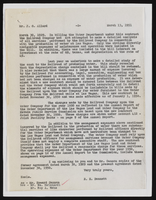Search the Special Collections and Archives Portal
Search Results

Letter from George C. Fish (Las Vegas) to Walter R. Bracken (Las Vegas), May 7, 1940
Date
1940-05-07
Archival Collection
Description
The owner of Railroad Pass Casino wanted water delivered to his casino, and wanted to build a flume next to the main tracks rather than build a spur. Fish was disinclined to sell any water where the only likely business was the freighting of water.
Text

Letter from an unknown author to W. H. Comstock, May 12, 1923
Date
1923-05-12
Archival Collection
Description
Letter comments on Las Vegas city election results. Letter is unsigned.
Text
Pagination
Refine my results
Content Type
Creator or Contributor
Subject
Archival Collection
Digital Project
Resource Type
Year
Material Type
Place
Language
Records Classification








